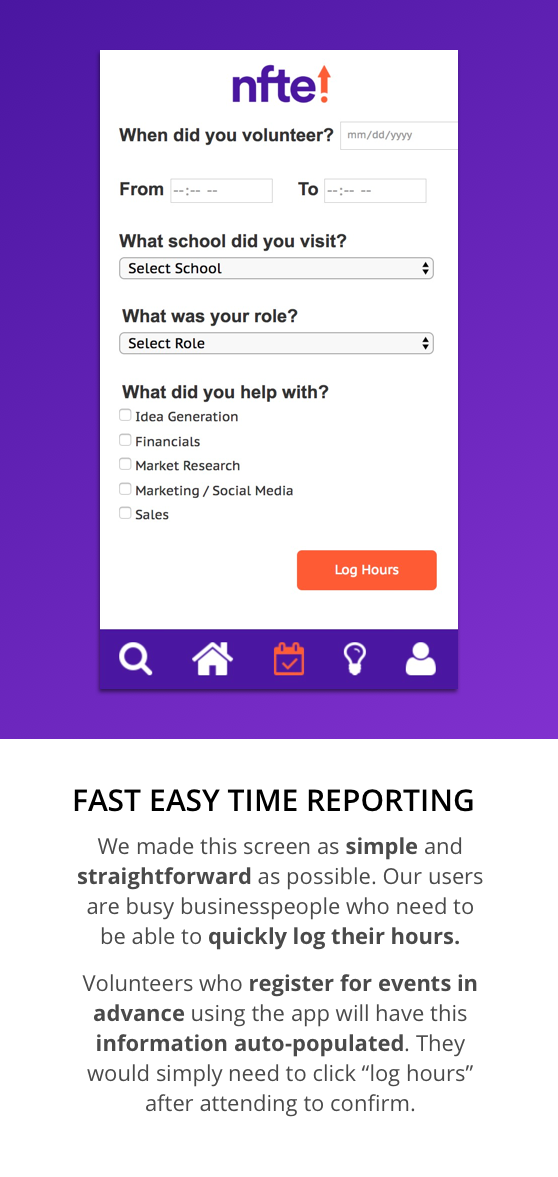Hacking for Humanity was a social innovation hackathon hosted by Girls in Tech Los Angeles and the Linux Foundation. Participating teams tackled challenges presented by a handful of non-profit organizations including Girl Scouts of America, the National Association of Social Workers (NASW), and the Network for Teaching Entrepreneurship (NFTE). Teams had a little under 48 hours to plan, build and present a viable creative solution to their chosen organization's challenge.
My team chose to tackle a challenge presented by the Network for Teaching Entrepreneurship (NFTE). NFTE partners work with schools in 9 states across the U.S. providing courses, workshops, training, and mentoring to students in under-resourced communities. Their goal is to activate students' entrepreneurial mindsets in order to promote success, self-reliance, creativity, and innovation.
The Challenge
The staff and administrators at NFTE were having trouble logging and tracking their volunteer's engagement hours. The organization needed an efficient system to gather this data so that they could maintain accurate records and demonstrate social impact and ROI to stakeholders, donors, and volunteers.
My Role: UX Designer
● conducted stakeholder interviews
● led brainstorming, ideation, and planning sessions
● delegated team duties
● collaboratively designed prototype
● reviewed all screens for design consistency, brand adherence, and usability
● collaboratively presented final prototype to panel of judges
Goals
Primary
● design a platform that will help busy volunteers quickly and accurately log their hours
● create a system that enables administrators to easily track volunteer engagement data
Secondary
● incorporate features that will boost engagement and keep users in the loop with the latest NFTE news and events
● enable users to find and register for future volunteer opportunities online
Design Approach
After learning more about NFTE's mission and their volunteers, I knew that my team was facing a human-centered challenge where empathic design, usability, and scalability would be key. I decided to lead my team following principles of Human-Centered Design and the Lean UX Design Thinking process.
Empathize
Stakeholder Interviews
In order to further understand and define NFTE's pain points and needs, my team sat down and talked with two key stakeholders. The Operations Manager and Program Manager answered our questions and provided valuable information about the inner workings of their organization. It quickly became clear that our design solution would need to address more than just the time logging problem. In order to create a comprehensive solution we needed to incorporate features that emphasize positive philanthropic human interactions and give volunteers opportunities to engage more deeply with NFTE students, schools, and educators.
Going beyond the stated challenge
Sitting down and chatting with stakeholders revealed some important UX gaps that needed to be addressed in our design solution...
● volunteers had a desire to stay in the loop and see the long term effects of their work with students and schools
● volunteers wanted to connect and collaborate with fellow volunteers in similar industries and from related professional backgrounds
Define
Identify + Prioritize User Needs
Now that we were ready to plan our design, I got my team together to run through an affinity mapping exercise. We all wrote down important ideas, insights, and observations and wrote them down to get a clear visual picture of the key elements we needed to focus on when designing our solution. We also worked collaboratively to come up with a user persona that we could reference throughout the rest of the design process to ensure that we were staying focused and creating features with the user in mind.


Ideate
As a team we sketched out some basic wireframes and user flows to make sure that we were all on the same page. It wasn't neat or pretty but it got us headed in the right direction!
Too many ideaS!
At this point in the process we had to work through one of the biggest challenges of working under an extremely tight deadline: reigning in the ideation. We were all so excited about the challenge and creating an awesome design that we couldn't help going off on tangents like "what if we added this?" and "wouldn't it be cool if it could do that?!". We quickly realized that in order to design a functional MVP in 24 hours, we needed to stay focused on meeting essential user/organizational needs.
Prototype




Results
We won 1st place!
My team with 3 NFTE staff members
What I learned
Fast Work Can Still be Good Work
This was my first Hackathon experience! I had a blast and learned a lot about teamwork, collaboration, and rapid prototyping. I tend to be a bit of a perfectionist and I like being able to take my time to methodically work through problems. With this challenge I didn't have the luxury of time but with the help of my team I was able to make it work. I learned that by following the Lean UX process and employing Design Thinking methods it was possible to get together with a group of 3 strangers and design an awesome, practical product in a very short period of time.